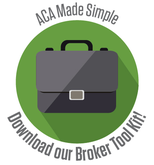By Kate Ranta on Jan 28, 2015 11:47:00 AM
As your clients’ valued dental insurance broker, you’ll want to make sure they are ACA compliant. Here is a checklist of ACA compliance rules about which you should be aware—and about which you can make them aware:
Pay or Play Mandate
For employers with 100 or more full-time employees, the Pay or Play mandate is in effect for plan years beginning on or after Jan. 1, This mandate requires that employers to whom this applies offer minimum essential coverage to full-time employees and their dependents that is both affordable and provides minimum value—or pay a penalty.
Employers would pay a penalty under the following scenarios:
1. The employer does not offer minimum essential coverage to full-time employees (or offers coverage to fewer than 70 percent of employees) and at least one full-time employee qualifies for a premium tax credit which would help pay for exchange-based coverage.
Penalty: $2,000 times the number of full-time employees, minus up to 80 employees for 2015.
2. The employer does offer coverage to at least 70 percent of full-time employees, but it is unaffordable or doesn’t provide minimum value for particular employees.
Penalty: $3,000 for each full-time employee that qualifies for a premium tax credit to help pay for exchange-based coverage.
Health Coverage Reporting
This reporting is the way the IRS will enforce both the mandate requiring individuals to have insurance and the employer shared responsibility mandate to offer coverage to full-time employees.
As such, employers are required to file forms annually with the IRS to report health coverage information. Therefore, a priority for your clients’ ACA compliance is to ensure that they have a system whereby they can collect, confirm and provide the data needed to report this information to the IRS.
Verifying Full-Time Employee Status
Since the ACA requires most employers to offer health coverage to full-time employees starting in plan year 2015, it’s imperative that your clients document who is a “full-time” employee at their companies. That’s because when coverage is not offered to an employee, your clients must be able to show that coverage wasn’t offered because the employee didn’t work a full-time schedule.
Keeping track of and reporting on full-time statuses should be pretty simple for most regular employees. But there may be challenges around reporting on employees who are ongoing but work variable hours—and for new employees who may not work full-time. Your clients may also be unsure about how to categorize seasonal employees, short-term employees and those who have breaks in service.
As their dental insurance broker, you can make suggestions to help keep your clients organized and able to properly report. For example, they’ll need a system that allows them to precisely track hours worked, categorize employees, verify benefits eligibility and document timelines for offers of coverage.
Any questions about your current Solstice products? Login to your portal on https://www.solsticemarketplace.com/
Want to start selling Solstice? Give us a call at 877-760-2247 or email us at sales@solsticebenefits.com





comments